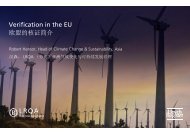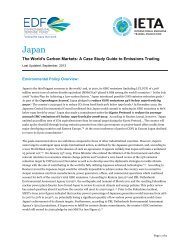Switzerland - International Emissions Trading Association
Switzerland - International Emissions Trading Association
Switzerland - International Emissions Trading Association
Create successful ePaper yourself
Turn your PDF publications into a flip-book with our unique Google optimized e-Paper software.
<strong>Switzerland</strong>The World’s Carbon Markets: A Case Study Guide to <strong>Emissions</strong> <strong>Trading</strong>Last Updated: May, 2013Brief History and Key Dates: The foundation of Swiss environmental policy was established in 1985 with the Act on the Protection of theEnvironment (PE Act), which was later revised in 1995 and 2003. In 1999, <strong>Switzerland</strong> adopted the Act on theReduction of CO2 <strong>Emissions</strong> (CO2 Act) as a supplementary environmental policy that centers on carbon dioxide (CO2)mitigation. The goals and mechanisms outlined in these two Acts were designed to help <strong>Switzerland</strong> meet its KyotoProtocol commitment of 8% greenhouse gas (GHG) reduction relative to 1990 for 2008-2012. The PE Actenumerates mitigation measures for non-CO2 GHGs from waste disposal (CH4), synthetic gases (HFC, PFC, SF6), andGHG precursors. The CO2 Act covers 80% of Swiss GHGs (See Figure 1). 1 In December 2011, revisions to the CO2 Actenumerated a CO2 reduction target of 20% below 1990 levels (52.5 MtCO2) by 2020. The country’s 2009 emissionswere about 51.95 MtCO2e. The revised CO2 Act became active on January 1, 2013. 2, 3Figure 1: Components of Swiss Kyoto Target Achievement. Source: FOEN 2009 4For 2008-2012, the overarching goal of the 1999 CO2 Act was to reduce CO2 emissions by 10% below 1990 levels.Specifically, the CO2 Act aimed for a 15% CO2 reduction from heating and industrial process fuels and an 8% CO2reduction from transport fuels. Instruments outlined in the 1999 CO2 Act included a CO2 levy 5 for heating, industrialprocess, and transportation fuels, as well as an emissions trading system (ETS) that included Kyoto Protocolflexibility mechanisms. 6 During 2001-2009, about 1,900 companies were covered by the levy and/or ETS outlined inthe 1999 CO2 Act. 7 The CO2 levy and the ETS are continuing for 2013-2020, in accordance with the December 2011CO2 Act revisions. 8The Swiss ETS was introduced on January 1, 2008 as an alternative option for complying with the national CO2 levyon heating, industrial process, and transport fuels, which also went into effect on that day. For the period 2008-2012, Page 1 of 8
firms covered by the levy had two choices: (1) pay the CO2 levy, or (2) voluntarily set a verified absolute emissionstarget and associated allowance allocation and participate in the Swiss ETS, which exempted them from paying theCO2 levy. 9 In essence, the CO2 levy functioned as a hard price ceiling for covered entities, and the option for ETSparticipation allowed firms to potentially pay a lower rate for emissions reductions than this ceiling price. For 2008and 2009 the CO2 levy was CHF $12/tCO2, and this rate increased to CHF $36/tCO2 for 2010-present. 10 The ETS(with some mandatory participation) and a CO2 levy has continued after 2012. December 2011 revisions to the SwissETS have increased its similarity to the EU ETS, thereby providing comparable market conditions for Swiss and EUindustries and improving the prospect of linking with the EU ETS. 11Summary of Key Policy Features:CAP/TARGET: As stated above, the CO2 levy and voluntary ETS were designed to help achieve the 1999 CO2 Act’sgoal of reducing CO2 by 10% relative to 1990 levels by 2010. The CO2 Act was implemented as a means ofachieving most of <strong>Switzerland</strong>’s Kyoto Protocol pledge to reduce total GHG emissions 8% relative to 1990 levelsfor 2008-2012. 12 For 2013-2020, <strong>Switzerland</strong> aims to reduce GHG emissions by 20% relative to 1990 by 2020;this target corresponds to an absolute reduction target of around 10.5 MtCO2e by 2020, down from 1990 emissions of52.7 MtCO2e. Estimates indicate that the CO2 Act will lead to reductions of 8.5 MtCO2e/year, 0.8 MtCO2e/year ofwhich would come from the ETS and 2 MtCO2e/year of which would come from the CO2 levy. The Federal Councilmay increase this 20% reduction target to up to 30%, if an international agreement were to arise. 13Swiss ETS targets are absolute. For 2010, the total cap was 3.42 MtCO2, 14 covering approximately 7% of Swissemissions.SCOPE/COVERAGE: The Swiss ETS point of obligation is company-level at the point of combustion, and, for2008-2012, it covered firms that set absolute caps—which were approved by federal authorities—for themselves inorder to receive exemption from the CO2 Act’s carbon levy. As of July 2011, about 950 companies had set caps, andabout 430 of these companies participated directly in the Swiss ETS, 15 where the emissions threshold for acompany to qualify as a direct participant was at least 0.25 MtCO2e/year. 16 Small-to-medium size entities (SMEs)were allowed to purchase allowances if they exceeded their cap, but they were not allocated allowances and, thus,were not considered direct participants. 17 See Figure 2.Figure 2: Breakdown of Swiss ETS Participants. Source: FOEN 2011 18For 2008-2012, the Swiss ETS covered heating and process fuels. Sectors with companies covered by the ETSincluded ceramics, paper, plastics, aluminum, glass, chemistry, metal-working and engineering, foodstuffs and lime, Page 2 of 8
foundries, printers, and haymakers. CO2 was the only gas covered by the program. 19 The compliance periodswithin the Swiss ETS were annual. 20For 2013-2020, the Federal Council will specify economic sectors from which installations that operate with high ormoderate GHG emissions may apply to participate in the ETS. In designating the covered economic sectors, theFederal Council must take into account: (1) the correlation between the CO2 levy burden and the value addition of thespecified economic sector, and (2) the extent to which the CO2 levy adversely affects the specified sector’s economiccompetitiveness. In addition, the Federal Council may mandate compulsory ETS participation fromsectors with high GHG emissions per installation. As was the case during 2008-2012, ETS participants are exemptedfrom the CO2 levy for 2013-2020. 21ALLOWANCE DISTRIBUTION: For 2008-2012, allowances were distributed freely to Swiss ETS participants.Participants received an emissions target for 2010, and this target doubled as the average yearly emissions for eachyear between 2008 and 2012. 22 The quantity of allowances that a company received was determined by a “bottomup”approach. Federal authorities verified the company’s potential to reduce CO2 emissions from both a technicaland economic standpoint, based on both projected production and CO2 emissions, and CO2 reduction measuresalready implemented. As mentioned above, small and medium enterprises (SMEs) that volunteered to set anemissions target or follow an emissions reduction plan did not receive free emissions allowances. If, however, theemissions for an SME exceeded the target level, then the company was allowed to purchase allowances in order tofulfill its commitment. 23For 2013-2020, the Federal Council will allocate allowances annually. Allocation will entail both free distributionand auctions, and the Federal Council will retain an appropriate number of emissions allowances each year in orderto have them available for new ETS participants. According to December 2011 revisions on the CO2 Act, the FederalCouncil shall regulate allowance allocation details, and “in doing so shall take account of comparable internationalregulations.” 24 This language opens the door for <strong>Switzerland</strong> to structure its allowance distribution similarly to the EUETS.FLEXIBILITY PROVISIONS: The Swiss ETS allows for companies to submit international offsets in order tomeet up to 8% of their compliance requirements. ERUs, CERs, and RMUs are accepted international offsets withinthe Swiss ETS. Temporary certificates from carbon sink projects (RMUs, tCERs, and lCERs), such as afforestation andreforestation, are allowed, but they cannot be banked for use in future commitment periods. The Federal Office forthe Environment (FOEN) may ask companies that use temporary credits to guarantee that additional offsets arepurchased once temporary credits expire. AAUs are permitted from countries that have a similar ETS to<strong>Switzerland</strong>. 25 See Figure 3.There are no limits for banking Swiss allowances or international AAUs for use in 2013-2020. The banking limitthrough the next commitment period for both CERs and ERUs is 2.5% of banked AAUs. However, companies maynot bank RMUs, tCERs, and lCERs for use in the next commitment period. 26 Banking and Borrowing wereallowed within the first commitment period, 2008-2012. 27For 2013-2020, measures carried out abroad may achieve a maximum of 75 per cent of additional reductions in GHGemissions. Reductions that qualify as “abroad reductions” must have been achieved without support of <strong>Switzerland</strong>,and, in developing countries, they must contribute to sustainable development while having zero negative social orecological impacts. 28 Page 3 of 8
Emission Credit Abbreviation Kyoto Code OffsetableAgainst KyotoTarget LimitTradableBankableCH EU IntlAssigned Amount AAU 1 ✓/ ✗ ✓ ✓ ✓ ✓UnitRemoval Unit RMU 2 ✓ ✓ ✓ ✓ ✗Emission Reduction ERU 3 ✓ ✓ ✓ ✓ ✓Unit (converted fromAAU)Emission Reduction ERU 4 ✓ ✓ ✓ ✓ ✓Unit (converted fromRMU)Certified Emission CER 5 ✓ ✓ ✓ ✓ ✓ReductionTemporary CER tCER 6 ✓ ✓ ✓ ✓ ✗Long-term CER lCER 7 ✓ ✓ ✓ ✓ ✗European UnionAllowanceEUA 0 ✗ ✗ ✓ ✗ ✓Table 1: Emission Credits: Types, Offsettability, and Tradability. Source: FOEN (2007) 29<strong>Switzerland</strong> and EU have initiated discussions about linkage. According to Aldy and Stavins (2012), this link islikely to become effective in 2014. 30 The Swiss are in favor of linking with the EU ETS because a larger marketprovides for greater cost-effective reduction potential, liquidity, price stability, and flexibility in achieving targets.Furthermore, linkage would enable Swiss companies to participate in the same market as EU business partners. 31According to FOEN (2011), “the Swiss Federal Council has also proposed that the Swiss ETS be adapted in the contextof the ongoing complete revision of the CO2 Act with a view to attaining a high level of compatibility with the EUETS.” 32MARKET REGULATION AND OVERSIGHT: Swiss ETS credits exist electronically and are listed on the FOENmanaged33 National <strong>Emissions</strong> <strong>Trading</strong> Registry, which is an online accounting system that, according toFOEN (2011), “ensures the issuance, holding, transfer, acquisition, cancellation and surrender of emission credits areaccurately recorded.” 34 After the federal government approves a company’s baseline, the agreed-upon quantity ofallowances (the amount of tax-exempt emissions) appears on the Registry under the company’s name. Companieswith emissions that exceed their allowance allocation buy credits on the Registry, and companies that emit belowtheir caps either bank or sell credits. The annual submission of credits occurs via the Registry and Registry data mustbe published electronically, unless specially protected. The Registry also connects Swiss ETS participants to Kyotoflexibility mechanisms, and transactions involving these units are subsequently approved by the UN.For 2008-2012, the penalty for companies that failed to achieve their Swiss ETS targets was retroactive payment ofthe carbon levy (plus interest) for each ton of CO2 emitted since the company’s exemption. 35 For 20013-2020,companies that fail to surrender enough emissions allowances and/or emissions reduction certificates must pay theConfederation CHF $125/tCO2e by the following year. 36COMPLEMENTARY AND SUPPLEMENTARY MEASURES: As noted above, the CO2 Act envisions the SwissETS and the carbon levy as alternative compliance options. This dual-policy approach allows companies to bypasscarbon levy payments if they voluntarily join the Swiss ETS. Beginning in 2013, specified companies face mandatoryETS participation. 37Page 4 of 8
For 2008-2012, a company was covered by the CO2 levy if its emissions exceeded a set percentage of its 1990emissions from fuel combustion. Beginning January 1 2009, a company that had emitted greater than 90% of its 1990emissions level in 2007 was covered by the levy. In 2010, a company that emitted greater than 86.5% of its 1990emissions in 2008, or greater than 85.5% in any subsequent year, was covered by the levy. 38 For 2008 and 2009, thelevy was CHF $12/tCO2. The rate was increased to CHF $36/tCO2 in 2010 and will remain in place through 2012. 39There were reduced levy rates for natural gas and biofuels. 40 In addition, the CO2 Act earmarked a maximum of up toCHF $200 million of government revenue from the CO2 levy for the financing of CO2 reduction measures inbuildings. 41The December 2011 revisions to the CO2 Act altered future (2013-2020) aspects of the CO2 levy. The revisionsenumerate how revenues are returned to the population. One-third of revenue from the CO2 levy, but no morethan CHF $300 million/year, may be used to finance measures to reduce CO2 emissions from buildings. In addition, amaximum of CHF $25 million/year of revenues from the CO2 levy may be allocated to the Technology Fund, whichwill use this money to guarantee loans to companies that aim to develop and market equipment and processes toreduce GHG emissions, facilitate the use of renewable energies, or encourage the economic use of natural resources. 42The rate of the levy has not change from CHF $36/tCO2e, and the Federal Council is not allowed to raise this levyabove CHF $120/tCO2e. The Federal Council has authority to designate economic sectors subject to the levy, takinginto account: (1) the correlation between the CO2 levy burden and the value added of the economic sector concerned;(2) the extent to which the CO2 levy adversely affects international competitiveness; and (3) the average GHGemissions agreed on for the years 2008-2012. The noncompliance penalty is CHF $125 for each excess tCO2e that isemitted. 43Apart from the carbon tax and the opt-in ETS compliance option, the CO2 Act of 1999 outlined the followingsupplementary measures: (1) a binding target for average CO2 emissions from new cars; (2) the implementation ofemissions reduction measures at home and abroad that allows producers of fossil propellant fuels to fulfill anobligation to cover a quarter of their emissions; and (3) enhanced climate change adaptation activity. 44 TheDecember 2011 CO2 Act revisions focus on emissions reductions from buildings, passenger cars, and sinks. 45In order to achieve <strong>Switzerland</strong>’s Kyoto Protocol commitment, the fourth Swiss national communication (2005)introduced and upheld the development of the following measures: 46• The January 10 2005 introduction of “climate cent,” a CHF $0.015 tax on transport fuels levied by mineral oilimporters to fund the Climate Cent Foundation. A primary objective of this foundation was to reduce 9 MtCO2during 2008-2012—one million tons domestically and eight million tons internationally via the purchase ofproject-based Kyoto-approved certificates. 47• The Swiss Energy program second phase (2006-2010) was officially continued (the first phase was 2000-2005).• The adoption of action plans for energy efficiency and renewable energy.The Fifth National Communication proposes the following post-2012 action: 48• Intensified focus on reducing transport emissions: (1) the introduction of CO2 limits from new cars; (2)domestic and international projects to reduce emissions from specific parts of the transport sector; and (3) theoption to introduce a CO2 levy on transport fuels.• Full compensation of emissions from combined cycle power plants.• Further climate change adaptation measures. Page 5 of 8
RESULTS: Each year over 2008-2010, ETS emissions were lower than targeted levels (see Table 2). According toFOEN (2011), “this outperformance demonstrates that the companies take their responsibilities towards the federalauthorities seriously and in some cases have invested early in carbon reduction measures.” 492008 2009 2010Emission Target(Allocated emissionallowance)CO2 <strong>Emissions</strong>(effective)Over-performance(surplus emissionallowances)3.3 MtCO2 3.1 MtCO2 3.42 MtCO22.9 MtCO2 2.6 MtCO2 2.85 MtCO20.4 MtCO2 0.5 MtCO2 0.57 MtCO2Table 2: Overview of ETS Performance 2008-2010. Source: Department of the Environment,Transport, Energy and Communications 50What Distinguishes This Policy?UNIQUE ASPECTS:1. For 2008-2012, the ETS worked as a voluntary opt-in program that provided an alternative way tocomply with a carbon levy. This is not how the vast majority of emissions trading systems have beendesigned. For 2013-2020, the Swiss ETS will move from a customized system to a standardized (EUstyle)system, as <strong>Switzerland</strong> continues linkage negotiations with the EU.2. Entities face absolute caps, but the system as a whole does not stipulate an absolute cap. This is a byproduct ofthe “bottom-up” allowance allocation methodology.3. The Swiss ETS is relatively small in size—3.42 MtCO2 in 2010. By contrast, the Tokyo ETS coversapproximately 13 MtCO2e annually, 51 and the EU ETS (Phase II) covers approximately 2,083 MtCO2e/year; so,the Swiss ETS’s emissions coverage is 26.3% that of the Tokyo ETS and approximately 0.16% that of the EU ETS.CHALLENGES:1. Modifying certain program characteristics in order to link with the EU ETS.2. The small size of this market results in less cost-effective reduction potential, liquidity, price stability, andflexibility in achieving targets. Page 6 of 8
Author Acknowledgements:If you have any comments or suggestions for this case study, please do not hesitate to contact lead authors:EDF co-author: Peter SopherEDF contact: Daniel Francis (dfrancis@edf.org)Environmental Defense Fund (EDF)1875 Connecticut Ave NW Ste. 600Washington, DCIETA co-author: Anthony MansellIETA contact: Anthony Mansell (Mansell@ieta.org)<strong>International</strong> <strong>Emissions</strong> <strong>Trading</strong> <strong>Association</strong> (IETA)20 F St NW Suite 700Washington, DCEDF and IETA would like to thank Ruben Lubowski, Pedro Piris-Cabezas, Jos Cozijnsen, Jennifer Andreassen, JoeBillick, Clayton Munnings, and Juerg Fuessler (INFRAS) for their contribution to Development of <strong>Emissions</strong> <strong>Trading</strong>Around the World.Disclaimer: The authors encourage readers to please contact them with any corrections, additions, revisions, or anyother comments, including any relevant citations. This will be invaluable in strengthening and updating the casestudies and ensuring they are as correct and informative as possible.1 FOEN (2009). “<strong>Switzerland</strong>’s Fifth National Communication under the UNFCCC.” Available at http://unfccc.int/resource/docs/natc/che_nc5.pdf2 FOEN (March 2011). “First formal round of negotiations held with EU for linking of emissions trading systems.” Available athttp://www.bafu.admin.ch/dokumentation/medieninformation/00962/index.html?lang=en&msg-id=380213 FOEN (December 2011). “Federal Act on the Reduction of CO2 <strong>Emissions</strong> (CO2 Act).” The Federal Assembly of the Swiss Confederation. Available at4Supra, Note 1.5 According to FOEN, “the term ‘levy’ has been used in order to distinguish the CO2 levy from a conventional tax, since the revenue from the levy is not channeledinto the national budget, but is returned in its entirety to the population (via reduction of health insurance premiums), to businesses that pay it (in the form of a cutin old-age pension contribution), and to the buildings program.” Source: Supra, Note 3.6 Supra, Note 1.7 Government of <strong>Switzerland</strong> (May 2011). “Swiss Climate Policy – an overview.” Federal Department of the Environment, Transport, Energy, and Communications(DETEC) and Federal Office of the Environment (FOEN). Available at http://www.up.ethz.ch/education/carbon_mitigation/cmitigation_ch_climatepolicy_fs11.pdf8 Supra, Note 3.9 Supra, Note 1.10 Meyer, Rolf (July 2009). “<strong>Emissions</strong> <strong>Trading</strong> in <strong>Switzerland</strong>.” Bern Mobil. Available athttp://www.uitp.org/advocacy/climate_change_docs/CO2_emission_trading_CH.pdf11 Supra, Note 3.12 Supra, Note 2.13 Supra, Note 3.14 Government of <strong>Switzerland</strong> (July 2011). “Exempt companies involved in emissions trading.” Available athttp://www.news.admin.ch/NSBSubscriber/message/attachments/23689.pdf15 FOEN (July 2011). “CO2-tax exempt companies exceed CO2-targets also in 2010.” Available athttp://www.bafu.admin.ch/dokumentation/medieninformation/00962/index.html?lang=en&msg-id=4023716 Reinaud, Julia and Cedric Philibert (December 2007). “<strong>Emissions</strong> <strong>Trading</strong>: Trends and Prospects.” OECD and IEA. Available athttp://www.oecd.org/dataoecd/60/38/39725657.pdf17 FOEN (January 2010). “<strong>Emissions</strong> trading for companies.” Available at http://www.bafu.admin.ch/emissionshandel/05545/index.html?lang=en18 Supra, Note 7.19 Supra, Note 16.20 Supra, Note 15.21 Supra, Note 3.22 Mace, M.J., Ilona Millar, Christoph Schwarte, Jason Anderson, Derik Broekhoff, Robert Bradley, Catherine Bowyer, and Robert Heilmayr (May 2008). “Analysisof the legal and organizational issues arising in linking the EU <strong>Emissions</strong> <strong>Trading</strong> Scheme to other existing and emerging emissions trading schemes.” FIELD.IEEP. WRI. Available at http://www.field.org.uk/files/Linking%20emission%20trading%20schemes_0.pdf23 Parliament of Australia (November 2010). “Swiss emissions trading scheme.” Available athttp://www.aph.gov.au/About_Parliament/Parliamentary_Departments/Parliamentary_Library/Browse_by_Topic/ClimateChange/responses/economic/emissions/international/swiss24 Supra, Note 3.25 FOEN (November 2007). “Emission Credits, Offsetting and <strong>Trading</strong>.” Available athttp://www.google.com/url?sa=t&rct=j&q=&esrc=s&source=web&cd=1&ved=0CB4QFjAA&url=http%3A%2F%2Fwww.bafu.admin.ch%2Femissionshandel%2F05564%2F05565%2Findex.html%3Flang%3Den%26download%3DNHzLpZeg7t%2Clnp6I0NTU042l2Z6ln1ad1IZn4Z2qZpnO2Yuq2Z6gpJCFdX54fGym162epYbg2c_JjKbNoKSn6A--&ei=QnaJUMrZNof40gH80ICABQ&usg=AFQjCNGaMYfuU8M0xEl98Q5wuJjICru_qQ&sig2=0YprQbaL5owwKj0MVaFqJw26 Supra, Note 25.27 Supra, Note 22.28 Supra, Note 3.29 Supra, Note 25.30 Aldy, Joseph and Robert Stavins (May 2012). “Post-Durban Climate Policy Architecture Based on Linkage of Cap-and-Trade Systems.” The Chicago Journal of<strong>International</strong> Law.31 FOEN (November 2010). “Linking the <strong>Emissions</strong> <strong>Trading</strong> System Swiss-EU.” Available athttp://www.bafu.admin.ch/emissionshandel/10923/index.html?lang=en32 Supra, Note 2.33 FOEN (December 2010). “The National <strong>Emissions</strong> <strong>Trading</strong> Registry.” Available at http://www.bafu.admin.ch/emissionshandel/05564/index.html?lang=enPage 7 of 8
34 Supra, Note 33.35 Hood, Christina (November 2010). “Reviewing Existing and Proposed <strong>Emissions</strong> <strong>Trading</strong> Systems.” OECD/IEA. Available athttp://www.iea.org/papers/2010/ets_paper2010.pdf36 Supra, Note 3.37 Supra, Note 3.38 Supra, Note 17.39 Supra, Note 14.40 Supra, Note 1.41 Supra, Note 2.42 Supra, Note 3.43 Supra, Note 3.44 Supra, Note 2.45 Supra, Note 3.46 Supra, Note 1.47 Supra, Note 10.48 Supra, Note 1.49 Supra, Note 15.50 Supra, Note 14.51 Bureau of the Environment, Tokyo Metropolitan Government (March 2010). “Tokyo Cap-and-Trade Program: Japan’s first mandatory emissions tradingscheme.” Available at http://www.kankyo.metro.tokyo.jp/en/attachement/Tokyo-cap_and_trade_program-march_2010_TMG.pdfPage 8 of 8


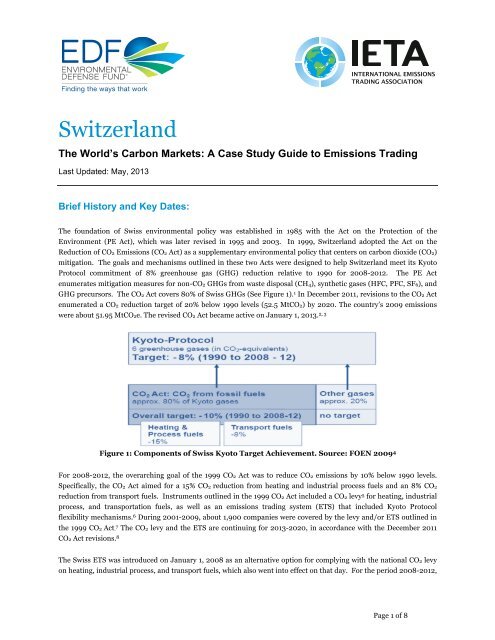


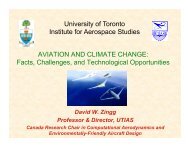
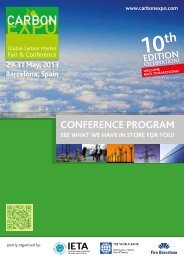
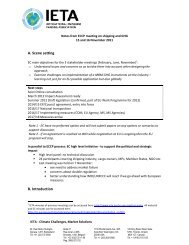

![South Korea [PDF] - International Emissions Trading Association](https://img.yumpu.com/38055599/1/190x245/south-korea-pdf-international-emissions-trading-association.jpg?quality=85)
